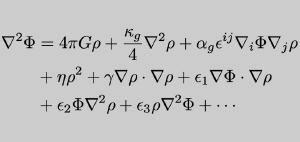Blog
Still in the Dark
8 July 2014
 Brian Koberlein
Brian KoberleinDark matter has an interesting history. It was first proposed to account for the fact that stars in our galaxy move much faster than they should around the galactic core. Evidence of dark matter has been seen in galactic collisions like the Bullet Cluster, as well as through gravitational lensing by galaxies. On the other hand, we have yet to find any direct detection of dark matter particles. In fact, many of the likely candidates for dark matter have been all but eliminated. Then there is the puzzling aspect of dwarf galaxies.
Although dark matter (specifically cold dark matter) works well on large cosmic scales and within large galaxies such as the Milky Way, it doesn’t seem to match up well with dwarf galaxies for several reasons. One of this is that computer simulations of dark matter predict that spiral galaxies should have many more satellite dwarf galaxies than they actually do. For example, models predict that the Milky Way should have about 500 satellite galaxies, which in reality it has only 11. It should also be the case that these satellite galaxies orbit the main galaxy in random directions, but studies of the Andromeda galaxy finds that satellites are somewhat clustered in a plane. So either something is up with dark matter, or there is an issue with the simulations.
Another problem with dwarf galaxies is known as the cuspy halo (or core-cusp) problem. Basically if dark matter is “cold”, it should gravitationally clump toward the center of a mass. This means the distribution of a galaxy’s dark matter halo should have a cusp in the center. We don’t see such dark matter clumping, even in our own galaxy. This is a particular problem in diffuse dwarf galaxies known as low surface brightness galaxies, or LSBs. With spiral galaxies such a the Milky way, you can argue that the central core of regular matter masks the effects of a dark matter cusp. But since LSBs are diffuse, and they still no cusp of dark matter, that argument isn’t very compelling.
So what if dark matter is wrong? The main alternative to dark matter are a range of modified gravity models. These propose that on galactic scales gravity differs from the form described by general relativity. The most popular of these modified gravity models is known as modified Newtonian dynamics, or MoND. It turns out that MoND works really well for LSB galaxies. The stellar motion of LSBs matches the predictions of MoND, so you could call it a win for modified gravity. But modified gravity also has several major problems. It doesn’t account for effects such as the Bullet Cluster, it is completely contradicted by the clustering of galaxies on large cosmic scales, and it incorrectly predicts the motions of galaxies within clusters.
So where does that leave us? At this point it is generally thought that dark matter not only exists, it accounts for most if not all of the effects we see. We have enough observational evidence to support the existence of dark matter, and effects such as large scale clustering can’t be described by any modified gravity model that also agrees with the experimental limits of special and general relativity. The big question is whether dark matter can account for all the effects such as LSBs, which it hasn’t done so far. Without a direct observation of dark matter, all sorts of variations have been proposed that might solve the LSB problem among others.
The alternative is that in addition to dark matter there is some new gravitational effect. Right now most astrophysicists don’t see that as very likely, but if we detect a type of dark matter that can’t account for dwarf galaxies, then it will be clear that modified gravity also plays a role. If that happens, it could revolutionize our understanding of the universe. It would require an extension of Newton and Einstein that are currently the foundation of modern cosmology.
We’re hoping that with more observational and experimental data we’ll be able to solve this mystery. Until then we’re a still a bit in the dark.
Up Next: Inflation solves many problems with the big bang, but we might never be able to prove it.